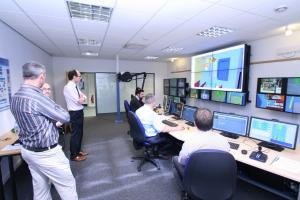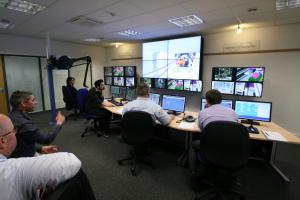Seeing is believing
Remote handling will be used to perform maintenance tasks on the machine and machine components; in a complex plant like ITER, this remote maintenance is fundamentally a manual activity. Operators in charge of remote handling operations will work from two dedicated areas on the ITER site: the Remote Handling Control Room for remote operations in and around the machine and the Hot Cell Operations Control Room for remote handling within the Hot Cell Facility.
The ITER maintenance campaigns will involve carrying out a set of tasks within a fixed period by the remote handling operations team. The policy of the Remote Handling Section is to organize the control rooms into standard work cells which can be easily configured for the execution of the particular tasks required for the shutdown.
Standardization in the remote handling control room is critical for the safe and efficient execution of remote handling operations. To promote standardization across a wide range of maintenance tasks, a contract was placed with Jacobs Engineering UK Limited for the implementation of a standard remote handling control room work cell. The effort, launched in July 2011, brought together specialists in remote handling (Oxford Technologies), robotics (Intermodalics), and human factors engineering (CCD, UK).
The standard work cell, which complies with ITER's high-level control system architecture, has been implemented in a dedicated room on the Oxford Technologies premises. To simulate operations, remote handling equipment controller software was developed according to the standard model with emulation of the control of real remote handling equipment. Wherever possible, recommended standard parts were used and validated in the work cell. Within this facility, the goal was to demonstrate that standard solutions can be applied to the ITER remote handling tasks; for each task demonstration, a wide variety of remote handling tools was simulated.
The standard work cell has been applied to execute three typical ITER remote handling tasks in simulation: the removal of the neutral beam cesium oven (demonstration of a neutral beam task); the de-contamination of a divertor cassette in a cleaning cell (demonstration of a Hot Cell Facility task); and the removal of a central divertor cassette (demonstration of an in-vessel task).
The simulations have shown that a standard remote handling work cell can be used for a range of ITER remote handling tasks. The team was able to demonstrate the viability of various standard parts: master arm, joysticks, emergency stops, virtual reality, communication middleware, and communication protocol. The standard work cell also demonstrated a workable layout that took "human factors engineering" into account.
The success of ITER operations will depend on the ability to remotely access and maintain critical components. This successful "proof-of-concept" work cell has demonstrated that ITER Organization standards are valid solutions for ITER remote handling.



